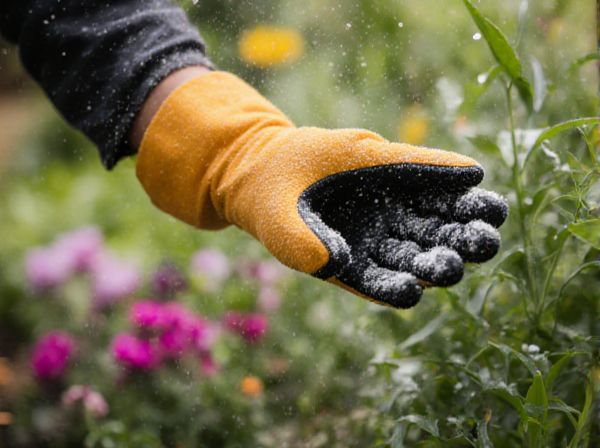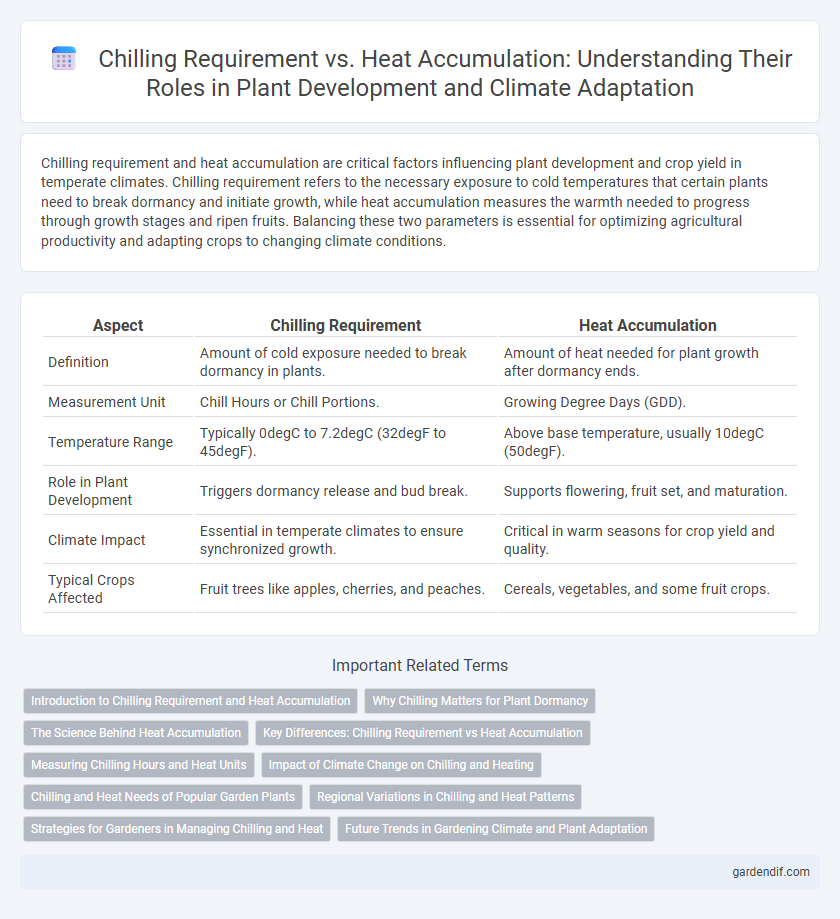
Chilling requirement vs Heat accumulation Illustration
Chilling requirement and heat accumulation are critical factors influencing plant development and crop yield in temperate climates. Chilling requirement refers to the necessary exposure to cold temperatures that certain plants need to break dormancy and initiate growth, while heat accumulation measures the warmth needed to progress through growth stages and ripen fruits. Balancing these two parameters is essential for optimizing agricultural productivity and adapting crops to changing climate conditions.
Table of Comparison
| Aspect | Chilling Requirement | Heat Accumulation |
|---|---|---|
| Definition | Amount of cold exposure needed to break dormancy in plants. | Amount of heat needed for plant growth after dormancy ends. |
| Measurement Unit | Chill Hours or Chill Portions. | Growing Degree Days (GDD). |
| Temperature Range | Typically 0degC to 7.2degC (32degF to 45degF). | Above base temperature, usually 10degC (50degF). |
| Role in Plant Development | Triggers dormancy release and bud break. | Supports flowering, fruit set, and maturation. |
| Climate Impact | Essential in temperate climates to ensure synchronized growth. | Critical in warm seasons for crop yield and quality. |
| Typical Crops Affected | Fruit trees like apples, cherries, and peaches. | Cereals, vegetables, and some fruit crops. |
Introduction to Chilling Requirement and Heat Accumulation
Chilling requirement refers to the necessary exposure to low temperatures that certain plants need to enter dormancy and ensure proper flowering and fruiting. Heat accumulation, measured in growing degree hours or days, quantifies the warmth a plant receives after dormancy to support growth and development. Understanding the balance between chilling requirement and heat accumulation is critical for optimizing crop yields and adapting to climate variations.
Why Chilling Matters for Plant Dormancy
Chilling requirement is essential for breaking plant dormancy by ensuring sufficient exposure to cold temperatures, which triggers metabolic changes needed for proper bud development and flowering. Heat accumulation alone cannot replace chilling because plants need to meet specific cold hour thresholds to avoid irregular growth and poor fruit yield. Meeting chilling requirements optimizes crop productivity by synchronizing flowering time and improving overall resilience to climate variability.
The Science Behind Heat Accumulation
Heat accumulation plays a critical role in plant development by regulating the timing of bud break and flowering through the measurement of growing degree days (GDD). Unlike chilling requirement, which ensures dormancy is properly broken by exposure to cold temperatures, heat accumulation tracks the progressive warming needed for metabolic activities and growth to resume. Studies indicate that accurate modeling of heat accumulation improves predictions of phenological stages, essential for adapting agricultural practices to shifting climate patterns.
Key Differences: Chilling Requirement vs Heat Accumulation
Chilling requirement refers to the number of cold hours below a specific temperature needed to break dormancy in plants, primarily fruit trees, ensuring proper flowering and fruit set. Heat accumulation, measured in growing degree hours or days, tracks the warmth required after chilling is fulfilled to promote bud development and maturation. The key difference lies in chilling requirement addressing cold exposure for dormancy release, while heat accumulation governs subsequent growth stages.
Measuring Chilling Hours and Heat Units
Measuring chilling hours involves quantifying the number of cumulative hours below a specific temperature threshold, typically between 0degC and 7degC, essential for the dormancy break in perennial crops. Heat units, often calculated as Growing Degree Hours (GDH) or Growing Degree Days (GDD), track accumulated warmth above a base temperature to predict plant development stages and optimize growing seasons. Accurate monitoring of chilling requirements and heat accumulation enables farmers to select appropriate crop varieties and improve yield predictions under varying climatic conditions.
Impact of Climate Change on Chilling and Heating
Climate change disrupts traditional chilling requirements by reducing the number of cold hours necessary for dormant buds to break, significantly affecting fruit trees and perennial crops. Increased temperatures accelerate heat accumulation, causing earlier flowering and potential mismatches with pollinator activity, which can reduce crop yields. Shifts in chilling and heating patterns threaten agricultural productivity and necessitate adaptive management strategies tailored to evolving climatic conditions.
Chilling and Heat Needs of Popular Garden Plants
Chilling requirement refers to the necessary exposure to cold temperatures that certain garden plants must experience to break dormancy and ensure proper flowering and fruiting. Heat accumulation, measured in growing degree hours or days, is crucial for the development and ripening of many popular garden species like apples, peaches, and tomatoes. Balancing chilling and heat needs is essential for optimizing growth cycles and maximizing yield in temperate climates.
Regional Variations in Chilling and Heat Patterns
Regional variations in chilling requirements and heat accumulation significantly impact crop phenology and yield potential. In colder climates, higher chilling hours are necessary to break dormancy, while warmer regions rely more on accumulated heat units for growth progression. Understanding these patterns enables precise agricultural planning and cultivar selection tailored to local climatic conditions.
Strategies for Gardeners in Managing Chilling and Heat
Gardeners can optimize plant growth by carefully balancing chilling requirements and heat accumulation to ensure proper dormancy release and flowering. Implementing site-specific microclimate management, such as shading to reduce heat stress or windbreaks to enhance chilling exposure, supports successful crop development. Utilizing climate-adapted cultivars with tailored chilling and heat needs further improves resilience against fluctuating temperature patterns.
Future Trends in Gardening Climate and Plant Adaptation
Chilling requirement and heat accumulation are critical factors in shaping future gardening climates and plant adaptation strategies, as shifting temperature patterns disrupt traditional growth cycles. Research indicates that decreased winter chill hours combined with increased heat accumulation may lead to asynchronous flowering and fruiting in temperate crops, necessitating the development of cultivars with modified dormancy cues. Adaptation efforts prioritize genetic selection and phenological modeling to sustain crop yields and maintain ecological balance in evolving climatic zones.
Chilling requirement vs Heat accumulation Infographic

 gardendif.com
gardendif.com